FAYOSIM- levonorgestrel and ethinyl estradiol and ethinyl estradiol kit
FAYOSIM by
Drug Labeling and Warnings
FAYOSIM by is a Prescription medication manufactured, distributed, or labeled by Lupin Pharmaceuticals, Inc., LUPIN LIMITED. Drug facts, warnings, and ingredients follow.
Drug Details [pdf]
-
HIGHLIGHTS OF PRESCRIBING INFORMATION
These highlights do not include all the information needed to use FAYOSIM safely and effectively. See full prescribing information for FAYOSIM.
FAYOSIM™ (levonorgestrel and ethinyl estradiol tablets USP, and ethinyl estradiol tablets USP), for oral use
Initial U.S. Approval: 1982WARNING: CIGARETTE SMOKING AND SERIOUS CARDIOVASCULAR EVENTS
See full prescribing information for complete boxed warning.
INDICATIONS AND USAGE
Fayosim is an estrogen/progestin COC indicated for use by women to prevent pregnancy (1).
DOSAGE AND ADMINISTRATION
DOSAGE FORMS AND STRENGTHS
Fayosim consist of 91 tablets in the following order (3):
- 42 pink tablets containing 0.15 mg levonorgestrel and 0.02 mg ethinyl estradiol,
- 21 white tablets containing 0.15 mg of levonorgestrel and 0.025 mg ethinyl estradiol, and
- 21 light blue tablets containing 0.15 mg of levonorgestrel and 0.03 mg ethinyl estradiol, and
- 7 mustard tablets containing 0.01 mg of ethinyl estradiol. (3)
CONTRAINDICATIONS
WARNINGS AND PRECAUTIONS
- Vascular risks: Stop Fayosim if a thrombotic event occurs. Stop Fayosim at least 4 weeks before and through 2 weeks after major surgery. Start Fayosim no earlier than 4 weeks after delivery, in women who are not breastfeeding. (5.1)
- Liver disease: Discontinue Fayosim if jaundice occurs. (5.2)
- High blood pressure: Do not prescribe Fayosim for women with uncontrolled hypertension or hypertension with vascular disease. (5.3)
- Carbohydrate and lipid metabolic effects: Monitor prediabetic and diabetic women taking Fayosim. Consider an alternate contraceptive method for women with uncontrolled dyslipidemias. (5.6)
- Headache: Evaluate significant change in headaches and discontinue Fayosim if indicated. (5.7)
- Uterine bleeding: Evaluate irregular bleeding or amenorrhea. (5.8)
ADVERSE REACTIONS
The most common adverse reactions (≥ 2%) in clinical trials for Fayosim were headaches, heavy/irregular vaginal bleeding, nausea/vomiting, acne, dysmenorrhea, weight increased, mood changes, anxiety/panic attack, breast pain and migraines (6).
To report SUSPECTED ADVERSE REACTIONS, contact Lupin Pharmaceuticals, Inc. at 1-800-399-2561 or FDA at 1-800-FDA-1088 or www.fda.gov/medwatch.
DRUG INTERACTIONS
Drugs or herbal products that induce certain enzymes, including CYP3A4, may decrease the effectiveness of COCs or increase breakthrough bleeding. Counsel patients to use a back-up or alternative method of contraception when enzyme inducers are used with COCs. (7.1)
USE IN SPECIFIC POPULATIONS
Nursing Mothers: Not recommended for nursing mothers; can decrease milk production. (8.3)
See 17 for PATIENT COUNSELING INFORMATION and FDA-approved patient labeling.
Revised: 11/2017
-
Table of Contents
FULL PRESCRIBING INFORMATION: CONTENTS*
WARNING: CIGARETTE SMOKING AND SERIOUS CARDIOVASCULAR EVENTS
1 INDICATIONS AND USAGE
2 DOSAGE AND ADMINISTRATION
2.1 How to Take Fayosim
2.2 How to Start Fayosim
2.3 Advice in Case of Gastrointestinal Disturbances
3 DOSAGE FORMS AND STRENGTHS
4 CONTRAINDICATIONS
5 WARNINGS AND PRECAUTIONS
5.1 Thromboembolic Disorders and Other Vascular Problems
5.2 Liver Disease
5.3 High Blood Pressure
5.4 Risk of Liver Enzyme Elevations with Concomitant Hepatitis C Treatment
5.5 Gallbladder Disease
5.6 Carbohydrate and Lipid Metabolic Effects
5.7 Headache
5.8 Bleeding Irregularities
5.9 COC Use Before or During Early Pregnancy
5.10 Depression
5.11 Carcinoma of the Breast and Cervix
5.12 Effect on Binding Globulins
5.13 Monitoring
5.14 Hereditary Angioedema
5.15 Chloasma
6 ADVERSE REACTIONS
6.1 Clinical Trial Experience
6.2 Postmarketing Experience
7 DRUG INTERACTIONS
7.1 Effects of Other Drugs on Combined Oral Contraceptives
7.2 Effects of Combined Oral Contraceptives on Other Drugs
7.3 Concomitant Use with Hepatitis C Vaccine (HCV) Combination Therapy – Liver Enzyme Elevation
7.4 Interference with Laboratory Tests
8 USE IN SPECIFIC POPULATIONS
8.1 Pregnancy
8.3 Nursing Mothers
8.4 Pediatric Use
8.5 Geriatric Use
8.6 Hepatic Impairment
8.7 Renal Impairment
10 OVERDOSAGE
11 DESCRIPTION
12 CLINICAL PHARMACOLOGY
12.1 Mechanism of Action
12.2 Pharmacodynamics
12.3 Pharmacokinetics
13 NONCLINICAL TOXICOLOGY
13.1 Carcinogenesis, Mutagenesis, Impairment of Fertility
14 CLINICAL STUDIES
16 HOW SUPPLIED/STORAGE AND HANDLING
16.1 How Supplied
16.2 Storage Conditions
17 PATIENT COUNSELING INFORMATION
- * Sections or subsections omitted from the full prescribing information are not listed.
-
BOXED WARNING
(What is this?)
WARNING: CIGARETTE SMOKING AND SERIOUS CARDIOVASCULAR EVENTS
Cigarette smoking increases the risk of serious cardiovascular events from combination oral contraceptives (COC) use. This risk increases with age, particularly in women over 35 years of age, and with the number of cigarettes smoked. For this reason, COCs should not be used by women who are over 35 years of age and smoke. [See CONTRAINDICATIONS (4)]
- 1 INDICATIONS AND USAGE
-
2 DOSAGE AND ADMINISTRATION
2.1 How to Take Fayosim
Instruct patients to take Fayosim once a day by mouth at the same time every day for 91 days. To achieve maximum contraceptive effectiveness, Fayosim must be taken exactly as directed and at intervals not exceeding 24 hours. For patient instructions regarding missed pills, see FDA-approved patient labeling.
2.2 How to Start Fayosim
For each 91-day course, take in the following order:
- Start the first pink tablet (0.15 mg of levonorgestrel and 0.02 mg ethinyl estradiol) on the first Sunday after the onset of menstruation. If menstruation begins on a Sunday, take the tablet on that day. Then take one pink tablet once a day for a total of 42 consecutive days. Use a non-hormonal back-up method of contraception (such as condoms and spermicide) for the first 7 days of treatment.
- One white tablet (0.15 mg of levonorgestrel and 0.025 mg ethinyl estradiol) once a day for 21 consecutive days.
- One light blue tablet (0.15 mg of levonorgestrel and 0.03 mg ethinyl estradiol) once a day for 21 days.
- One mustard tablet (0.01 mg of ethinyl estradiol) once a day for 7 days. Bleeding should occur during mustard tablet use.
Begin the next and all subsequent 91-day courses of Fayosim without interruption on the same day of the week (i.e., Sunday) on which the patient began her first dose. Follow the same schedule as the initial 91-day course: pink tablet once a day for 42 days, white tablet once a day for 21 days, light blue tablet once a day for 21 days, and mustard tablet once a day for 7 days. If the patient does not immediately start her next pill pack, instruct her to protect herself from pregnancy by using a non-hormonal back-up method of contraception until she has taken a pink tablet daily for 7 consecutive days.
If unscheduled spotting or bleeding occurs, instruct the patient to continue on the same regimen. If the bleeding is persistent or prolonged, advise the patient to consult her healthcare provider.
For a postpartum woman who is not breastfeeding or after a second trimester abortion, start Fayosim no earlier than four weeks postpartum due to increased risk of thromboembolism. If the patient starts on Fayosim postpartum and has not yet had a period, evaluate for possible pregnancy, and instruct her to use an additional method of contraception until she has taken a pink tablet for 7 consecutive days. Consider the possibility of ovulation and conception prior to initiation.
2.3 Advice in Case of Gastrointestinal Disturbances
In case of severe vomiting or diarrhea, absorption may not be complete and additional contraceptive measures should be taken. If vomiting or diarrhea occurs within 3 to 4 hours after taking a pink, white or light blue tablet, handle this as a missed tablet [see FDA-approved patient labeling].
-
3 DOSAGE FORMS AND STRENGTHS
Fayosim (levonorgestrel and ethinyl estradiol tablets, and ethinyl estradiol tablets) are available as round, film-coated, biconvex tablets debossed with "LU" on one side, packaged in Extended-Cycle wallet, each containing a 13-week supply of tablets in the following order:
- 42 pink tablets, each containing 0.15 mg of levonorgestrel and 0.02 mg ethinyl estradiol: debossed with "U19" on the other side
- 21 white tablets containing 0.15 mg of levonorgestrel and 0.025 mg ethinyl estradiol: debossed with "U20" on the other side
- 21 light blue tablets containing 0.15 mg of levonorgestrel and 0.03 mg ethinyl estradiol: debossed with "V21" on the other side and
- 7 mustard tablets containing 0.01 mg of ethinyl estradiol: debossed with "V22" on the other side
-
4 CONTRAINDICATIONS
Do not prescribe Fayosim to women who are known to have the following conditions:
A high risk of arterial or venous thrombotic diseases. Examples include women who are known to:
- Smoke, if over age 35 [see BOXED WARNING and WARNINGS AND PRECAUTIONS (5.1)].
- Have deep vein thrombosis or pulmonary embolism, now or in the past [see WARNINGS AND PRECAUTIONS (5.1)].
- Have cerebrovascular disease [see WARNINGS AND PRECAUTIONS (5.1)].
- Have coronary artery disease [see WARNINGS AND PRECAUTIONS (5.1)].
- Have thrombogenic valvular or thrombogenic rhythm diseases of the heart (for example, subacute bacterial endocarditis with valvular disease, or atrial fibrillation) [see WARNINGS AND PRECAUTIONS (5.1)].
- Have inherited or acquired hypercoagulopathies [see WARNINGS AND PRECAUTIONS (5.1)].
- Have uncontrolled hypertension [see WARNINGS AND PRECAUTIONS (5.3)].
- Have diabetes with vascular disease [see WARNINGS AND PRECAUTIONS (5.6].
- Have headaches with focal neurological symptoms or have migraine headaches with or without aura if over age 35 [see WARNINGS AND PRECAUTIONS (5.7)].
Liver tumors, benign or malignant, or liver disease [see WARNINGS AND PRECAUTIONS (5.2) and USE IN SPECIFIC POPULATIONS (8.6)].
Undiagnosed abnormal uterine bleeding [see WARNINGS AND PRECAUTIONS (5.8)].
Pregnancy, because there is no reason to use COCs during pregnancy [see WARNINGS AND PRECAUTIONS (5.9) and USE IN SPECIFIC POPULATIONS (8.1)].
Breast cancer or other estrogen- or progestin-sensitive cancer, now or in the past [see WARNINGS AND PRECAUTIONS (5.11)].
Use of Hepatitis C drug combinations containing ombitasvir/paritaprevir/ritonavir, with or without dasabuvir, due to the potential for ALT elevations [see WARNINGS AND PRECAUTIONS (5.4)].
-
5 WARNINGS AND PRECAUTIONS
5.1 Thromboembolic Disorders and Other Vascular Problems
Stop Fayosim if an arterial or deep venous thrombotic event (VTE) occurs. Stop Fayosim if there is unexplained loss of vision, proptosis, diplopia, papilledema, or retinal vascular lesions. Evaluate for retinal vein thrombosis immediately.
If feasible, stop Fayosim at least 4 weeks before and through 2 weeks after major surgery or other surgeries known to have an elevated risk of VTE.
Start Fayosim no earlier than 4 weeks after delivery, in women who are not breastfeeding. The risk of postpartum VTE decreases after the third postpartum week, whereas the risk of ovulation increases after the third postpartum week.
The use of COCs increases the risk of VTE. However, pregnancy increases the risk of VTE as much or more than the use of COCs. The risk of VTE in women using COCs is 3 to 9 per 10,000 woman-years. The risk of VTE is highest during the first year of use of a COC. Data from a large, prospective cohort safety study of various COCs suggest that this increased risk, as compared to that in non-COC users, is greatest during the first 6 months of COC use. Data from this safety study indicate that the greatest risk of VTE is present after initially starting a COC or restarting (following a 4-week or greater pill-free interval) the same or a different COC. The risk of thromboembolic disease due to COCs gradually disappears after COC use is discontinued.
Use of Fayosim provides women with more hormonal exposure on a yearly basis than conventional monthly oral contraceptives containing the same strength synthetic estrogens and progestins (an additional 9 and 13 weeks of exposure to progestin and estrogen, respectively, per year). In the clinical trial, three cases of deep vein thrombosis were reported.
Use of COCs also increases the risk of arterial thromboses such as strokes and myocardial infarctions, especially in women with other risk factors for these events. COCs have been shown to increase both the relative and attributable risks of cerebrovascular events (thrombotic and hemorrhagic strokes), although, in general, the risk is greatest among older (>35 years of age), and hypertensive women who also smoke. COCs also increase the risk for stroke in women with other underlying risk factors.
Use COCs with caution in women with cardiovascular disease risk factors.
5.2 Liver Disease
Do not use Fayosim in women with acute viral hepatitis or severe (decompensated) cirrhosis of the liver [see CONTRAINDICATIONS (4)].Acute disturbances of liver function may necessitate the discontinuation of COC use until markers of liver function return to normal and COC causation has been excluded. Discontinue Fayosim if jaundice develops.
Liver Tumors
Fayosim is contraindicated in women with benign and malignant liver tumors [see CONTRAINDICATIONS (4)]. Hepatic adenomas are associated with COC use. An estimate of the attributable risk is 3.3 cases/100,000 COC users. Rupture of hepatic adenomas may cause death through intra-abdominal hemorrhage.
Studies have shown an increased risk of developing hepatocellular carcinoma in long-term (> 8 years) COC users. However, the attributable risk of liver cancers in COC users is less than one case per million users.
5.3 High Blood Pressure
Fayosim is contraindicated in women with uncontrolled hypertension or hypertension with vascular disease [see CONTRAINDICATIONS (4)]. For women with well-controlled hypertension, monitor blood pressure and stop Fayosim if blood pressure rises significantly.
An increase in blood pressure has been reported in women taking COCs, and this increase is more likely in older women and with extended duration of use. The incidence of hypertension increases with increasing concentration of progestin.
5.4 Risk of Liver Enzyme Elevations with Concomitant Hepatitis C Treatment
During clinical trials with the Hepatitis C combination drug regimen that contains obmitasvir/paritaprevir/ritonavir, with or without dasabuvir, ALT elevations greater than 5 times the upper limit of normal (ULN), including some cases greater than 20 times the ULN, were significantly more frequent in women using ethinyl estradiol-containing medications, such as COCs. Discontinue Fayosim prior to starting therapy with the combination drug regimen ombitasvir/paritaprevir/ritonavir, with or without dasabuvir [see CONTRAINDICATIONS (4)]. Fayosim can be restarted approximately 2 weeks following completion of treatment with the Hepatitis C combination drug regimen.
5.5 Gallbladder Disease
Studies suggest a small increased relative risk of developing gallbladder disease among COC users. Use of COCs may also worsen existing gallbladder disease.
A past history of COC-related cholestasis predicts an increased risk with subsequent COC use. Women with a history of pregnancy-related cholestasis may be at an increased risk for COC-related cholestasis.
5.6 Carbohydrate and Lipid Metabolic Effects
Carefully monitor prediabetic and diabetic women who are taking Fayosim. COCs may decrease glucose tolerance in a dose-related fashion.
Consider alternative contraception for women with uncontrolled dyslipidemias. A small proportion of women will have adverse lipid changes while on COCs.
Women with hypertriglyceridemia, or a family history thereof, may be at an increased risk of pancreatitis when using COCs.
5.7 Headache
If a woman taking Fayosim develops new headaches that are recurrent, persistent, or severe, evaluate the cause and discontinue Fayosim if indicated.
Consider discontinuation of Fayosim in the case of increased frequency or severity of migraine during COC use (which may be prodromal of a cerebrovascular event) [see CONTRAINDICATIONS (4)].
5.8 Bleeding Irregularities
Bleeding and/or spotting that occurs at any time while taking the first 84 tablets (pink, white and light blue) of each extended-cycle regimen is considered "unscheduled" bleeding/spotting. Bleeding that occurs during the time a woman takes the seven tablets (mustard) containing 10 mcg of ethinyl estradiol is considered "scheduled" bleeding.
Unscheduled and Scheduled Bleeding and Spotting
Unscheduled (breakthrough) bleeding and spotting sometimes occur in patients on COCs, especially during the first 3 months of use. If unscheduled bleeding persists or occurs after previously regular cycles on Fayosim, check for causes such as pregnancy or malignancy. If pathology and pregnancy are excluded, bleeding irregularities may resolve over time or with a change to a different COC.
Before prescribing Fayosim, consider the occurrence of fewer scheduled menses (4 per year instead of 13 per year) against the occurrence of increased unscheduled bleeding and/or spotting. A 12- month open-label study of the efficacy of Fayosim in preventing pregnancy assessed scheduled and unscheduled bleeding [see CLINICAL STUDIES (14)] in 3,597 women who completed 34,087 28-day cycles of exposure. A total of 178 (4.9%) of the women discontinued Fayosim, at least in part, due to bleeding or spotting.
Scheduled (withdrawal) bleeding and/or spotting remained fairly stable over time, with an average of 3 to 4 days of bleeding and/or spotting per each 91-day cycle.
Unscheduled bleeding and unscheduled spotting decreased over successive 91-day cycles. Table 1 below presents the number of days with unscheduled bleeding, spotting, and unscheduled bleeding and/or spotting in Treatment Cycles 1 to 4.
Table 1 Number of Unscheduled Bleeding, Spotting and Bleeding and/or Spotting Days per 91-day Cycle Q1 = Quartile 1: 25% of women had ≤ this number of days of unscheduled bleeding/spotting
Median: 50% of women had ≤ this number of days of unscheduled bleeding/spotting
Q3 = Quartile 3: 75% of women had ≤ this number of days of unscheduled bleeding/spotting
Cycle (N)
Days of Unscheduled Bleeding per 84-Day Interval
Median Days Per Subject- Month
Mean
Q1
Median
Q3
1
(3330)
7.2
0
4
10
1.0
2
(2820)
3.3
0
0
4
0.0
3
(2433)
2.5
0
0
3
0.0
4
(2213)
2.2
0
0
2
0.0
Cycle (N)
Days of Unscheduled Spotting per 84-Day Interval
Median Days Per Subject- Month
Mean
Q1
Median
Q3
1
(3330)
10.7
2
7
15
1.8
2
(2820)
6.7
0
3
9
0.8
3
(2433)
5.2
0
2
6
0.5
4
(2213)
4.4
0
1
5
0.3
Cycle (N)
Days of Unscheduled Bleeding and/or Spotting per 84-Day Interval
Median Days Per Subject- Month
Mean
Q1
Median
Q3
1
(3330)
17.9
5
14
27
3.5
2
(2820)
10.0
1
5
14
1.3
3
(2433)
7.7
0
3
10
0.8
4
(2213)
6.6
0
3
8
0.8
Figure 1 shows the percent of Fayosim subjects in the primary clinical trial with ≥ 7 days or ≥ 20 days of unscheduled bleeding and/or spotting, or just unscheduled bleeding, during each 91-day treatment cycle.
Figure 1: Percent of Women Taking Fayosim Who Reported Unscheduled Bleeding and/or Spotting
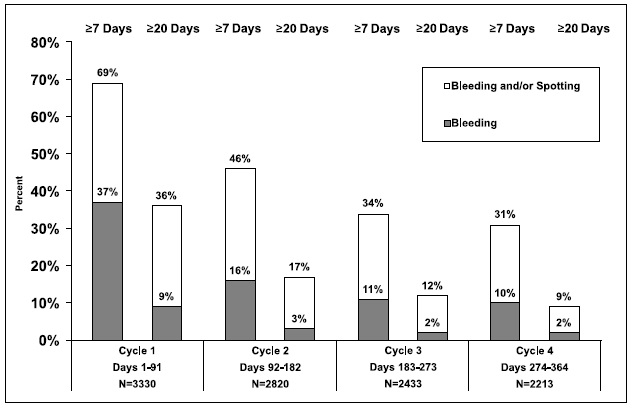
Women who are not pregnant and use Fayosim may experience amenorrhea. Based on data from the clinical trial, amenorrhea occurred in approximately 1.9% of women during Cycle 1, 7.7% during Cycle 2, 10.7% during Cycle 3, and 10.1% during Cycle 4 using Fayosim. Rule out pregnancy in the event of amenorrhea. Some women may experience amenorrhea or oligomenorrhea after stopping COCs, especially when such a condition was pre-existent.
5.9 COC Use Before or During Early Pregnancy
Extensive epidemiological studies have revealed no increased risk of birth defects in women who have used oral contraceptives prior to pregnancy. Studies also do not suggest a teratogenic effect, particularly in so far as cardiac anomalies and limb-reduction defects are concerned, when taken inadvertently during early pregnancy. Discontinue Fayosim if pregnancy is confirmed.
The administration of oral contraceptives to induce withdrawal bleeding should not be used as a test for pregnancy [see USE IN SPECIFIC POPULATIONS (8.1)].
5.10 Depression
Carefully observe women with a history of depression and discontinue Fayosim if depression recurs to a serious degree. Six cases of suicidality (suicide attempts and suicidal behavior) were reported in the clinical trial; several of these cases occurred in women with a psychiatric history.
5.11 Carcinoma of the Breast and Cervix
Fayosim is contraindicated in women who currently have or have had breast cancer because breast cancer may be hormonally sensitive [see CONTRAINDICATIONS (4)].
There is substantial evidence that COCs do not increase the incidence of breast cancer. Although some past studies have suggested that COCs might increase the incidence of breast cancer, more recent studies have not confirmed such findings.
Some studies suggest that COCs are associated with an increase in the risk of cervical cancer or intraepithelial neoplasia. However, there is controversy about the extent to which these findings are due to differences in sexual behavior and other factors.
5.12 Effect on Binding Globulins
The estrogen component of COCs may raise the serum concentrations of thyroxine-binding globulin sex hormone-binding globulin and cortisol-binding globulin. The dose of replacement thyroid hormone or cortisol therapy may need to be increased.
5.13 Monitoring
A woman who is taking COCs should have a yearly visit with her healthcare provider for a blood pressure check and for other indicated health care.
-
6 ADVERSE REACTIONS
The following serious adverse reactions with the use of COCs are discussed elsewhere in the labeling:
- Serious cardiovascular events and stroke [see BOXED WARNING and WARNINGS AND PRECAUTIONS (5.1)]
- Vascular events [see WARNINGS AND PRECAUTIONS (5.1)]
- Liver disease [see WARNINGS AND PRECAUTIONS (5.2)]
Adverse reactions commonly reported by COC users are:
- Irregular uterine bleeding
- Nausea
- Breast tenderness
- Headache
6.1 Clinical Trial Experience
Because clinical trials are conducted under widely varying conditions, adverse reaction rates observed in the clinical trials of a drug cannot be directly compared to the rates in the clinical trials of another drug and may not reflect the rates observed in practice.
The safety data described below are from a 12-month, US, open-label study, which enrolled women aged 18 to 40, of whom 3,597 took at least one dose of Fayosim (2,661 woman-years of exposure) [see CLINICAL STUDIES (14)].
Adverse Reactions Leading to Study Discontinuation
13.3% of the women discontinued from the clinical trial due to an adverse reaction; the most common adverse reactions (≥ 1% of women) leading to discontinuation were heavy/irregular bleeding (5.0%), mood swings/alteration/affect lability (1.4%), headaches/migraines (1.3%), weight increased (1.3%) and acne (1.0%).
Common Adverse Reactions (≥ 2% of women)
Headaches (12.2%), heavy/irregular vaginal bleeding (9.7%), nausea/vomiting (8.8%), acne (5.4%), dysmenorrhea (5.4%), weight increased (4.6%), mood changes (depression, depressed mood, crying, major depression, affective disorder, depression suicidal, dysthymic disorder) (2.9%), anxiety/panic attack (2.4%), breast tenderness/pain/discomfort (2.2%), migraine (2.0%).
Serious Adverse Reactions (≥ 2 women)
Abortion Spontaneous, Suicide Attempt, Cholecystitis/Cholelithiasis, Deep Vein Thrombosis, Ectopic Pregnancy.
6.2 Postmarketing Experience
The following adverse reactions have been identified during post-approval use of other extended-cycle COCs containing levonorgestrel and ethinyl estradiol. Because these reactions are reported voluntarily from a population of uncertain size, it is not always possible to reliably estimate their frequency or establish a causal relationship to drug exposure.
Gastrointestinal disorders
Abdominal distension, vomiting
General disorders and administration site conditions
Chest pain, fatigue, malaise, edema peripheral, pain
Immune system disorders
Hypersensitivity reaction
Investigations
Blood pressure increased
Musculoskeletal and connective tissue disorders
Muscle spasms, pain in extremity
Nervous system disorders
Dizziness, loss of consciousness
Psychiatric disorders
Insomnia
Reproductive and breast disorders
Dysmenorrhea
Respiratory, thoracic and mediastinal disorders
Pulmonary embolism, pulmonary thrombosis
Skin and subcutaneous tissue disorders
Alopecia
Vascular disorders
Thrombosis
-
7 DRUG INTERACTIONS
Consult the labeling of concurrently-used drugs to obtain further information about interactions with hormonal contraceptives or the potential for enzyme alterations.
No drug-drug interaction studies were conducted with Fayosim.
7.1 Effects of Other Drugs on Combined Oral Contraceptives
Substances Diminishing the Efficacy of COCs
Drugs or herbal products that induce certain enzymes, including cytochrome P450 3A4 (CYP3A4), may decrease the effectiveness of COCs or increase breakthrough bleeding. Some drugs or herbal products that may decrease the effectiveness of hormonal contraceptives include phenytoin, barbiturates, carbamazepine, bosentan, felbamate, griseofulvin, oxcarbazepine, rifampicin, topiramate and products containing St. John's wort. Interactions between oral contraceptives and other drugs may lead to breakthrough bleeding and/or contraceptive failure. Counsel women to use an alternative method of contraception or a back-up method when enzyme inducers are used with COCs, and to continue back-up contraception for 28 days after discontinuing the enzyme inducer to ensure contraceptive reliability.
Substances Increasing the Plasma Concentrations of COCs
Co-administration of atorvastatin and certain COCs containing EE increase AUC values for EE by approximately 20%. Ascorbic acid and acetaminophen may increase plasma EE concentrations, possibly by inhibition of conjugation. CYP3A4 inhibitors such as itraconazole or ketoconazole may increase plasma hormone concentrations.
Human immunodeficiency virus (HIV)/ Hepatitis C Virus (HCV) Protease Inhibitors and Non-nucleoside Reverse Transcriptase Inhibitors
Significant changes (increase or decrease) in the plasma concentrations of estrogen and progestin have been noted in some cases of co-administration with HIV/HCV protease inhibitors or with non-nucleoside reverse transcriptase inhibitors.
Antibiotics
There have been reports of pregnancy while taking hormonal contraceptives and antibiotics, but clinical pharmacokinetic studies have not shown consistent effects of antibiotics on plasma concentrations of synthetic steroids.
7.2 Effects of Combined Oral Contraceptives on Other Drugs
COCs containing EE may inhibit the metabolism of other compounds. COCs have been shown to significantly decrease plasma concentrations of lamotrigine, likely due to induction of lamotrigine glucuronidation. This may reduce seizure control; therefore, dosage adjustments of lamotrigine may be necessary.
Women on thyroid hormone replacement therapy may need increased doses of thyroid hormone because serum concentration of thyroid-binding globulin increases with use of COCs.
7.3 Concomitant Use with Hepatitis C Vaccine (HCV) Combination Therapy – Liver Enzyme Elevation
Do not co-administer Fayosim with HCV drug combinations containing ombitasvir/paritaprevir/ritonavir, with or without dasabuvir, due to potential for ALT elevations [see WARNINGS AND PRECAUTIONS (5.4)].
-
8 USE IN SPECIFIC POPULATIONS
8.1 Pregnancy
There is little or no increased risk of birth defects in women who inadvertently use COCs during early pregnancy. Epidemiologic studies and meta-analyses have not found an increased risk of genital or non-genital birth defects (including cardiac anomalies and limb-reduction defects) following exposure to low dose COCs prior to conception or during early pregnancy.
The administration of COCs to induce withdrawal bleeding should not be used as a test for pregnancy. COCs should not be used during pregnancy to treat threatened or habitual abortion.
8.3 Nursing Mothers
When possible, advise the nursing mother to use other forms of contraception until she has weaned her child. COCs can reduce milk production in breastfeeding mothers. This is less likely to occur once breastfeeding is well established; however, it can occur at any time in some women. Small amounts of oral contraceptive steroids and/or metabolites are present in breast milk.
8.4 Pediatric Use
Safety and efficacy of Fayosim have been established in women of reproductive age. Efficacy is expected to be the same for postpubertal adolescents under the age of 18 as for users 18 years and older. Use of Fayosim before menarche is not indicated.
8.5 Geriatric Use
Fayosim has not been studied in women who have reached menopause and is not indicated in this population.
8.6 Hepatic Impairment
No studies have been conducted to evaluate the effect of hepatic impairment on the disposition of Fayosim. However, steroid hormones may be poorly metabolized in patients with hepatic impairment. Acute or chronic disturbances of liver function may necessitate the discontinuation of COC use until markers of liver function return to normal and COC causation has been excluded. [See CONTRAINDICATIONS (4) and WARNINGS AND PRECAUTIONS (5.2)].
- 10 OVERDOSAGE
-
11 DESCRIPTION
Fayosim (levonorgestrel and ethinyl estradiol tablets USP, and ethinyl estradiol tablets USP) is an extended-cycle oral contraceptive. Fayosim consists of 42 pink tablets containing 0.15 mg levonorgestrel and 0.02 mg ethinyl estradiol, 21 white tablets containing 0.15 mg levonorgestrel and 0.025 mg ethinyl estradiol, and 21 light blue tablets containing 0.15 mg levonorgestrel and 0.03 mg ethinyl estradiol, and 7 mustard tablets containing 0.01 mg ethinyl estradiol. Levonorgestrel is a progestin and ethinyl estradiol is an estrogen.
The structural formulas, molecular formulas, molecular weights, and chemical names for the active components are shown below:
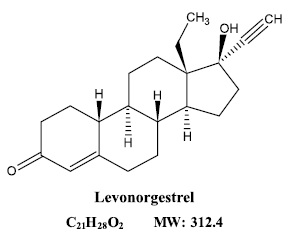
Levonorgestrel is chemically 18,19-Dinorpregn-4-en-20-yn-3-one, 13-ethyl-17-hydroxy-(17α)-(-)-.
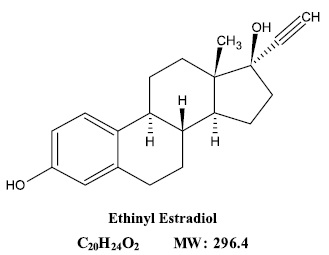
Ethinyl Estradiol is 19-Norpregna-1,3,5(10)-trien-20-yne-3,17-diol, (17α)-.
Each pink tablet contains the following inactive ingredients:
Anhydrous lactose, croscarmellose sodium, FD&C blue #1 aluminum lake, FD&C Red #40 aluminum lake, hypromellose, magnesium stearate, microcrystalline cellulose, polyethylene glycol, povidone and titanium dioxide.
Each white tablet contains the following inactive ingredients:
Anhydrous lactose, croscarmellose sodium, hypromellose, magnesium stearate, microcrystalline cellulose, polyethylene glycol, povidone and titanium dioxide.
Each light blue tablet contains the following inactive ingredients:
Anhydrous lactose, croscarmellose sodium, FD&C blue #1 aluminum lake, FD&C yellow #6 aluminum lake, hypromellose, iron oxide yellow, magnesium stearate, microcrystalline cellulose, polyethylene glycol, povidone and titanium dioxide.
Each mustard tablet contains the following inactive ingredients:
Anhydrous lactose, FD&C yellow #6 aluminum lake, hypromellose, iron oxide yellow, magnesium stearate, microcrystalline cellulose, polacrillin potassium, polyethylene glycol, polysorbate 80 and titanium dioxide.
Ethinyl Estradiol Tablets USP meets USP Dissolution Test 2.
-
12 CLINICAL PHARMACOLOGY
12.1 Mechanism of Action
COCs lower the risk of becoming pregnant primarily by suppressing ovulation. Other possible mechanisms may include cervical mucus changes that inhibit sperm penetration and endometrial changes that reduce the likelihood of implantation.
12.3 Pharmacokinetics
Ethinyl estradiol and levonorgestrel are absorbed with maximum plasma concentrations occurring within 2 hours after Fayosim administration. Levonorgestrel is completely absorbed after oral administration (bioavailability nearly 100%) and is not subject to first-pass metabolism. Ethinyl estradiol is absorbed from the gastrointestinal tract but, due to first-pass metabolism in gut mucosa and liver, the bioavailability of ethinyl estradiol is approximately 40%. The effect of food on the rate and the extent of levonorgestrel and ethinyl estradiol absorption following oral administration of Fayosim have not been evaluated.
The mean plasma pharmacokinetic parameters of levonorgestrel following administration of another levonorgestrel/ethinyl estradiol combination tablet with an equal dose of levonorgestrel for 84 days, in healthy women are reported in Table 2.
Table 2: Mean Pharmacokinetic Parameters for 150 mcg Levonorgestrel Following Administration of a Levonorgestrel/ethinyl estradiol Combination Tablet Once Daily for 84 Days
AUC0 to 24 hr(mean ± SD)
Cmax (mean ± SD)
Tmax (mean ± SD)
Day 1
18.2 ± 6.1 ng·hr/mL
3.0 ± 1.0 ng/mL
1.3 ± 0.4 hours
Day 21
64.4 ± 25.1 ng·hr/mL
6.2 ± 1.6 ng/mL
1.3 ± 0.4 hours
Day 84
60.2 ± 24.6 ng·hr/mL
5.5 ± 1.6 ng/mL
1.3± 0.3 hours
Following repeated daily dosing of levonorgestrel/ethinyl estradiol oral contraceptives, levonorgestrel plasma concentrations accumulate more than predicted based on single-dose pharmacokinetics, due in part, to increased SHBG levels that are induced by ethinyl estradiol, and a possible reduction in hepatic metabolic capacity.
Systemic exposure to ethinyl estradiol following administration of a LNG/EE combination tablet increases linearly in an approximate dose-proportional manner over the range of doses of 20 mcg to 30 mcg within this product. Systemic exposure to EE (as assessed by AUC) at steady state following administration of levonorgestrel/ethinyl estradiol oral contraceptives is approximately 20% higher than expected based on single-dose data for the dose range of 20 to 30 mcg.
Distribution
The apparent volume of distribution of levonorgestrel is reported to be approximately 1.8 L/kg. Levonorgestrel is about 97.5 to 99% protein-bound, principally to sex hormone binding globulin (SHBG) and, to a lesser extent, serum albumin.
The apparent volume of distribution of ethinyl estradiol is reported to be approximately 4.3 L/kg. Ethinyl estradiol is about 95 to 97% bound to serum albumin. Ethinyl estradiol does not bind to SHBG, but induces SHBG synthesis, which leads to decreased levonorgestrel clearance.
Metabolism
Following absorption, levonorgestrel is conjugated at the 17β-OH position to form sulfate and to a lesser extent, glucuronide conjugates in plasma. Significant amounts of conjugated and unconjugated 3α, 5β-tetrahydrolevonorgestrel are also present in plasma, along with much smaller amounts of 3α,5α-tetrahydrolevonorgestrel and 16β-hydroxylevonorgestrel. Levonorgestrel and its phase I metabolites are excreted primarily as glucuronide conjugates. Metabolic clearance rates may differ among individuals by several-fold, and this may account in part for the wide variation observed in levonorgestrel concentrations among users.
First-pass metabolism of ethinyl estradiol involves formation of ethinyl estradiol-3-sulfate in the gut wall, followed by 2-hydroxylation of a portion of the remaining untransformed ethinyl estradiol by hepatic cytochrome P-450 3A4 (CYP3A4). Levels of CYP3A4 vary widely among individuals and can explain the variation in rates of ethinyl estradiol hydroxylation. Hydroxylation at the 4-, 6-, and 16- positions may also occur, although to a much lesser extent than 2-hydroxylation. The various hydroxylated metabolites are subject to further methylation and/or conjugation.
Excretion
About 45% of levonorgestrel and its metabolites are excreted in the urine and about 32% are excreted in feces, mostly as glucuronide conjugates. The mean terminal elimination half-life for levonorgestrel after a single dose of Fayosim ranged from 36 to 41 hours.
Ethinyl estradiol is excreted in the urine and feces as glucuronide and sulfate conjugates, and it undergoes enterohepatic recirculation. The terminal elimination half-life of ethinyl estradiol following single doses of Fayosim is approximately 16.5 hours.
- 13 NONCLINICAL TOXICOLOGY
-
14 CLINICAL STUDIES
In a 12-month, multicenter, open-label, single-arm clinical trial conducted in the US, 3,667 women, 18 to 40 years old, were enrolled and 3,565 were treated for up to four 91-day cycles, which equates to thirteen 28-day cycles, to assess the safety and efficacy of Fayosim, completing the equivalent of 33,895 28-day cycles of exposure. The racial demographic of those treated was: Caucasian (64%), African-American (19%), Hispanic (11%), Asian (2%), and Other (3%). There were no exclusions for body mass index (BMI) or weight. The weight range of those women treated was 83 to 402 lbs., with a mean weight of 162.5 lbs. Among the women in the trial, 44% were current hormonal contraceptive users, 39% were prior users (who had used hormonal contraceptives in the past), and 17% were new starters. Of treated women, 13.2% were lost to follow-up, 12.8% discontinued due to an adverse event, and 6.1% discontinued by withdrawing their consent.
The pregnancy rate (Pearl Index [PI]) in women aged 18 to 35 years was 3.19 pregnancies per 100 woman-years of use (95% confidence interval 2.49, 4.03), based on 70 pregnancies that occurred after the onset of treatment and up to and including 7 days after the last pill. Cycles in which conception did not occur, but which included the use of backup contraception, were not included in the calculation of the PI. The PI includes patients who did not take the drug correctly.
-
16 HOW SUPPLIED/STORAGE AND HANDLING
16.1 How Supplied
Fayosim (levonorgestrel and ethinyl estradiol tablets USP, and ethinyl estradiol tablets USP) are available in Extended-Cycle Wallets each containing a 13-week supply of tablets in the following order:
- 42 pink, round, biconvex film-coated tablets, each containing 0.15 mg of levonorgestrel and 0.02 mg ethinyl estradiol: debossed with "LU" on one side and "U19" on the other side.
- 21 white, round, biconvex film-coated tablets, containing 0.15 mg of levonorgestrel and 0.025 mg ethinyl estradiol: debossed with "LU" on one side and "U20" on the other side.
- 21 light blue, round, biconvex film-coated tablets, containing 0.15 mg of levonorgestrel and 0.03 mg ethinyl estradiol: debossed with "LU" on one side and "V21" on the other side.
- 7 mustard, round, biconvex film-coated tablets, containing 0.01 mg of ethinyl estradiol: debossed with "LU" on one side and "V22" on the other side.
1 extended cycle wallet of 91 tablets which is packed in a pouch (NDC: 68180-860-11). Such one pouch is packed in a carton (NDC: 68180-860-12).
2 extended cycle wallets of 91 tablets each which is packed in a pouch (NDC: 68180-860-11). Such two pouches are packed in a carton (NDC: 68180-860-13).
-
17 PATIENT COUNSELING INFORMATION
See FDA-approved patient labeling (Patient Information).
Counsel patients on the following information:
- Cigarette smoking increases the risk of serious cardiovascular events from COC use, and that women who are over 35 years old and smoke should not use COCs.
- Increased risk of VTE compared to non-users of COCs is greatest after initially starting a COC or restarting (following a 4-week or greater pill-free interval) the same or a different COC.
- Fayosim does not protect against HIV-infection (AIDS) and other sexually transmitted infections.
- The Warnings and Precautions associated with COCs.
- Fayosim is not to be used during pregnancy; if pregnancy occurs during use of Fayosim, instruct the patient to stop further intake.
- Take one tablet daily by mouth at the same time every day. Instruct patients what to do in the event pills are missed. See WHAT TO DO IF YOU MISS PILLS section of FDA-Approved Patient Labeling.
- Use a back-up or alternative method of contraception when enzyme inducers are used with COCs.
- COCs may reduce breast milk production. This is less likely to occur if breastfeeding is well established.
- Women who start COCs postpartum, and who have not yet had a period, should use an additional method of contraception until they have taken a pink tablet for 7 consecutive days.
- Amenorrhea may occur. Consider pregnancy in the event of amenorrhea, and rule out pregnancy if amenorrhea is associated with symptoms of pregnancy, such as morning sickness or unusual breast tenderness.
-
PATIENT PACKAGE INSERT
Guide for Using Fayosim™
[levonorgestrel and ethinyl estradiol tablets USP (0.15 mg/0.02 mg, 0.15 mg/0.025 mg and 0.15 mg/0.03 mg), and ethinyl estradiol tablets USP (0.01 mg)]
Do not use Fayosim if you smoke cigarettes and are over 35 years old. Smoking increases your risk of serious cardiovascular side effects from birth control pills, including death from heart attack, blood clots or stroke. This risk increases with age and the number of cigarettes you smoke.
Birth control pills help to lower the chances of becoming pregnant. They do not protect against HIV infection (AIDS) and other sexually transmitted infections.
What is Fayosim?
Fayosim is a birth control pill. It contains two female hormones, an estrogen called ethinyl estradiol and a progestin called levonorgestrel.
How Well Does Fayosim Work?
Your chance of getting pregnant depends on how well you follow the directions for taking your birth control pills. The more carefully you follow the directions, the less chance you have of getting pregnant.
Based on the results of a single clinical study lasting 12 months, 2 to 4 women out of 100 women may get pregnant during the first year they use Fayosim.
The following chart shows the chance of getting pregnant for women who use different methods of birth control. Each box on the chart contains a list of birth control methods that are similar in effectiveness. The most effective methods are at the top of the chart. The box on the bottom of the chart shows the chance of getting pregnant for women who do not use birth control and are trying to get pregnant.
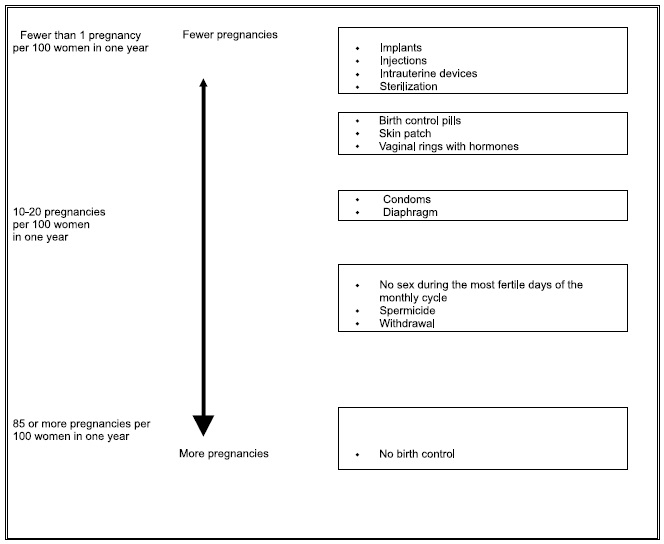
1. Take one pill every day at the same time. Take pills in the order directed on the Extended-Cycle wallet.
Do not skip pills or delay taking your pills. If you miss pills (including starting the pack late), you could get pregnant. The more pills you miss, the more likely you are to get pregnant.
2. You may have spotting or light bleeding, or feel sick to your stomach during the first few months of taking Fayosim. If you feel sick to your stomach, do not stop taking the pill. The problem will usually go away. If it doesn't go away, check with your healthcare provider.
If you vomit or have diarrhea within 4 hours after taking your pill, follow the instructions in "What To Do If You Miss Pills."
3. Missing pills can also cause spotting or light bleeding, even when you take the missed pills later. On the days you take 2 pills to make up for missed pills, you could also feel a little sick to your stomach.
4. If you have trouble remembering to take Fayosim, talk to your healthcare provider about how to make pill-taking easier or about using another method of birth control.
Before you start taking Fayosim
1. Decide what time of day you want to take your pill. It is important to take it at about the same time every day.
2. Look at your Extended-Cycle Tablet Wallet. Your Extended-Cycle Wallet consists of 3 blister strips that hold 91 individually sealed pills (a 13-week or 91-day cycle). The 91 pills consist of 42 pink tablets, each containing 0.15 mg of levonorgestrel and 0.02 mg ethinyl estradiol, 21 white tablets containing 0.15 mg of levonorgestrel and 0.025 mg ethinyl estradiol, 21 light blue tablets containing 0.15 mg of levonorgestrel and 0.03 mg ethinyl estradiol, and 7 mustard tablets containing 0.01 mg of ethinyl estradiol.
Blister strip 1 contains 4 rows of 7 pink pills.
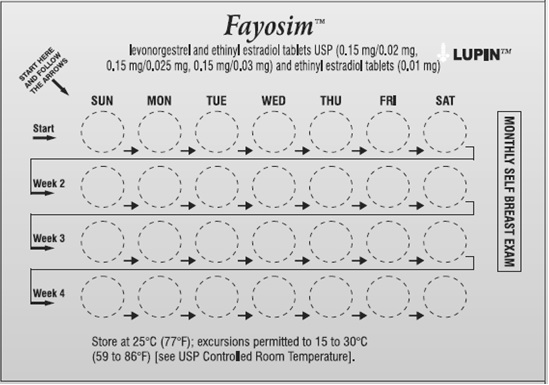
Blister strip 2 contains 2 rows of 7 pink pills (a total of 14 pink pills) followed by 2 rows of 7 white pills (a total of 14 white pills).
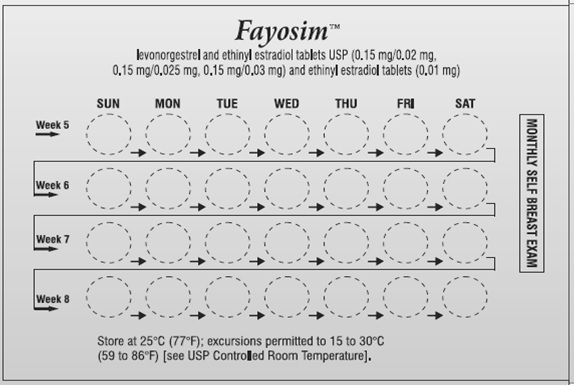
Blister strip 3 contains 1 row of 7 white pills, followed by three rows of 7 light blue pills (a total of 21 light blue pills), followed by the last row, which contains 7 mustard pills.

- Where on the first blister strip in the pack to start taking pills (upper left corner at the start arrow) and
- In what order to take the pills (follow the weeks and arrow).
4. Be sure you have another kind of birth control (such as condoms and spermicides) ready at all times, to use as a back-up in case you miss pills.
- Take the first pink pill on the Sunday after your period starts, even if you are still bleeding. If your period begins on Sunday, start the first pink pill that same day.
- Use another method of birth control (such as condoms and spermicides) as a back-up method if you have sex anytime from the Sunday you start your first pink pill until the next Sunday (first 7 days). If you have been using a different hormonal method of birth control (such as a different pill, the "patch," or the "vaginal ring"), you need to use another method of birth control (such as condoms and spermicides) each time you have sex after stopping your old method of birth control until you have taken Fayosim for 7 days.
- If you have recently given birth and have not yet had a period, use another method of birth control if you have sex (such as condoms and spermicides) as a back-up method until you have taken Fayosim for 7 days.
1. Take one pill at the same time every day until you have taken the last pill in the Extended-Cycle wallet.
- Do not skip pills even if you are experiencing spotting or bleeding or feel sick to your stomach (nausea).
- Do not skip pills even if you do not have sex very often.
- Do not skip the mustard pills because they are not placebo pills ("sugar pills"). They contain ethinyl estradiol.
- After taking the last mustard pill, start taking the first pink pill from a new Extended-Cycle Wallet the very next day (this should be on a Sunday) regardless of when your period started.
3. If you miss your scheduled period when you are taking the mustard pills, contact your healthcare provider because you may be pregnant. If you are pregnant, you should stop taking Fayosim.
If you MISS 1 pink, white or light blue pill:
1. Take it as soon as you remember. Take the next pill at your regular time. This means you may take 2 pills in 1 day.
2. You do not need to use a back-up birth control method if you have sex.
If you MISS 2 pink, white or light blue pills in a row:
1. Take 2 pills on the day you remember, and 2 pills the next day.
2. Then take 1 pill a day until you finish the pack.
3. You could become pregnant if you have sex in the 7 days after you miss two pills. You MUST use another birth control method (such as condoms and spermicide) as a back up for the 7 days after you restart your pills.
If you MISS 3 OR MORE pink, white or light blue pills in a row:
1. Do not take the missed pills. Keep taking 1 pill every day as indicated on the pack until you have completed all of the remaining pills in the pack. For example: If you resume taking the pill on Thursday, take the pill under "Thursday" and do not take the missed pills. You may experience bleeding during the week following the missed pills.
2. You could become pregnant if you have sex during the days of missed pills or during the first 7 days after restarting your pills.
3. You MUST use a non-hormonal birth control method (such as condoms and spermicide) as a back-up when you miss pills and for the first 7 days after you restart your pills. If you do not have your period when you are taking the mustard pills, call your healthcare provider because you may be pregnant.
If you MISS ANY of the 7 mustard colored pills:
1. Take the next scheduled pill at the scheduled time.
2. You do not need a back-up method of birth control.
Finally, if you are still not sure what to do about the pills you have missed
1. Use a back-up method anytime you have sex.
2. Keep taking one pill each day until you contact your healthcare provider.
Who Should Not Take Fayosim?
Your healthcare provider will not give you Fayosim if you have:
- Ever had breast cancer or any cancer that is sensitive to female hormones
- Liver disease, including liver tumors
- Been prescribed any Hepatitis C drug combination containing ombitasvir/paritaprevir/ritonavir, with or without dasabuvir. This may increase levels of the liver enzyme "alanine aminotransferase" (ALT) in the blood
- Ever had blood clots in your arms, legs, eyes, or lungs
- Ever had a stroke
- Ever had a heart attack
- Certain heart valve problems or heart rhythm abnormalities that can cause blood clots to form in the heart
- An inherited problem with your blood that makes it clot more than normal
- High blood pressure that medicine can't control
- Diabetes with kidney, eye, nerve or blood vessel damage
- Ever had certain kinds of severe migraine headaches with aura, numbness, weakness or changes in vision, or have any migraine headaches if you are over age 35
Also, do not take birth control pills if you:
- Smoke and are over 35 years old
- Are pregnant
- Have any unexplained bleeding from the vagina
Birth control pills may not be a good choice for you if you have ever had jaundice (yellowing of the skin or eyes) caused by pregnancy.
Tell your healthcare provider if you have ever had any of the above conditions (your healthcare provider may recommend another method of birth control.)
What Else Should I Know About Taking Fayosim?
Birth control pills do not protect you against any sexually transmitted infection, including HIV, the virus that causes AIDS.
Do not skip any pills, even if you do not have sex often.
Birth control pills should not be taken during pregnancy. However, birth control pills taken by accident during pregnancy are not known to cause birth defects.
You should stop Fayosim at least four weeks before you have major surgery and not restart it for at least two weeks after the surgery, due to an increased risk of blood clots.
If you are breastfeeding, consider another birth control method until you are ready to stop breastfeeding. Birth control pills that contain estrogen, like Fayosim, may decrease the amount of milk you make. A small amount of the pill's hormones pass into breast milk.
Tell your healthcare provider about all medicines and herbal products that you take. Some medicines and herbal products may make birth control pills less effective, including:
- barbiturates
- bosentan
- carbamazepine
- felbamate
- griseofulvin
- oxcarbazepine
- phenytoin
- rifampin
- St. John's wort
- topiramate
Use a back-up or alternative birth control method when you take medicines that may make birth control pills less effective.
If you have vomiting or diarrhea, your birth control pills may not work as well. Use another birth control method, like condoms and spermicide, until you check with your healthcare provider.
Birth control pills may interact with lamotrigine, an anticonvulsant used for epilepsy. This may increase the risk of seizures, so your healthcare provider may need to adjust the dose of lamotrigine.
Women on thyroid hormone replacement therapy may need increased doses of thyroid hormone.
What Are The Most Serious Risks Of Taking Birth Control Pills?
Like pregnancy, birth control pills increase the risk of serious blood clots, especially in women who have other risk factors, such as smoking, obesity, or age greater than 35. This increased risk is highest when you first start taking birth control pills and when you restart the same or different birth control pills after not using them for a month or more.
It is possible to die from a problem caused by a blood clot, such as a heart attack or a stroke. Some examples of serious blood clots are blood clots in the:
- Legs (deep vein thrombosis)
- Lungs (pulmonary embolus)
- Eyes (loss of eyesight)
- Heart (heart attack)
- Brain (stroke)
Women who take birth control pills may get:
- High blood pressure
- Gallbladder problems
- Rare cancerous or noncancerous liver tumors
All of these events are uncommon in healthy women.
Call your healthcare provider right away if you have:
- Persistent leg pain
- Sudden shortness of breath
- Sudden blindness, partial or complete
- Severe pain or pressure in your chest
- Sudden, severe headache unlike your usual headaches
- Weakness or numbness in an arm or leg, or trouble speaking
- Yellowing of the skin or eyeballs
What Are Common Side Effects Of Birth Control Pills?
The most common side effects of birth control pills are:
- Spotting or bleeding between menstrual periods
- Nausea
- Breast tenderness
- Headache
These side effects are usually mild and usually disappear with time.
Less common side effects are:
- Acne
- Less sexual desire
- Bloating or fluid retention
- Blotchy darkening of the skin, especially on the face
- High blood sugar, especially in women who already have diabetes
- High fat (cholesterol, triglyceride) levels in the blood
- Depression, especially if you have had depression in the past. Call your healthcare provider immediately if you have any thoughts of harming yourself.
- Problems tolerating contact lenses
- Weight gain
This is not a complete list of possible side effects. Talk to your healthcare provider if you develop any side effects that concern you. You may report side effects to the FDA at 1-800-FDA-1088.
No serious problems have been reported from a birth control pill overdose, even when accidentally taken by children.
Do Birth Control Pills Cause Cancer?
Birth control pills do not appear to cause breast cancer. However, if you have breast cancer now, or have had it in the past, do not use birth control pills because some breast cancers are sensitive to hormones.
Women who use birth control pills may have a slightly higher chance of getting cervical cancer. However, this may be due to other reasons such as having more sexual partners.
What Should I Know About My Period When Taking Fayosim?
When you take Fayosim, which has a 91-day extended dosing cycle, you should expect to have 4 scheduled periods per year (bleeding when you are taking the 7 mustard pills). Each period is likely to last about 3 to 4 days. However, you will probably have more bleeding or spotting between your scheduled periods than if you were using a birth control pill with a 28-day dosing cycle. This bleeding or spotting tends to decrease with each additional cycle. Do not stop taking Fayosim because of this bleeding or spotting. If the spotting continues for more than 7 consecutive days or if the bleeding is heavy, call your healthcare provider.
What If I Miss My Scheduled Period When Taking Fayosim?
You should consider the possibility that you are pregnant if you miss your scheduled period (no bleeding on the days that you are taking mustard pills). Because scheduled periods are less frequent when you are taking Fayosim, notify your healthcare provider that you have missed your period and that you are taking Fayosim. Also notify your healthcare provider if you have symptoms of pregnancy such as morning sickness or unusual breast tenderness. It is important that your healthcare provider evaluates you to determine if you are pregnant. Stop taking Fayosim if it is determined that you are pregnant.
What If I Want To Become Pregnant?
You may stop taking the pill whenever you wish. Consider a visit with your healthcare provider for a pre-pregnancy checkup before you stop taking the pill.
General Advice About Fayosim
Your healthcare provider prescribed Fayosim for you. Do not share Fayosim with anyone else. Keep Fayosim out of the reach of children.
If you have concerns or questions, ask your healthcare provider. You may also ask your healthcare provider for a more detailed label written for medical professionals.
-
PRINCIPAL DISPLAY PANEL
Fayosim™ (levonorgestrel and ethinyl estradiol tablets USP, 0.15 mg/0.02 mg, 0.15 mg/0.025 mg, 0.15 mg/0.03 mg and ethinyl estradiol tablets 0.01 mg)
1 extended cycle wallet of 91 tablets in a carton (NDC: 68180-860-12).
Rx Only
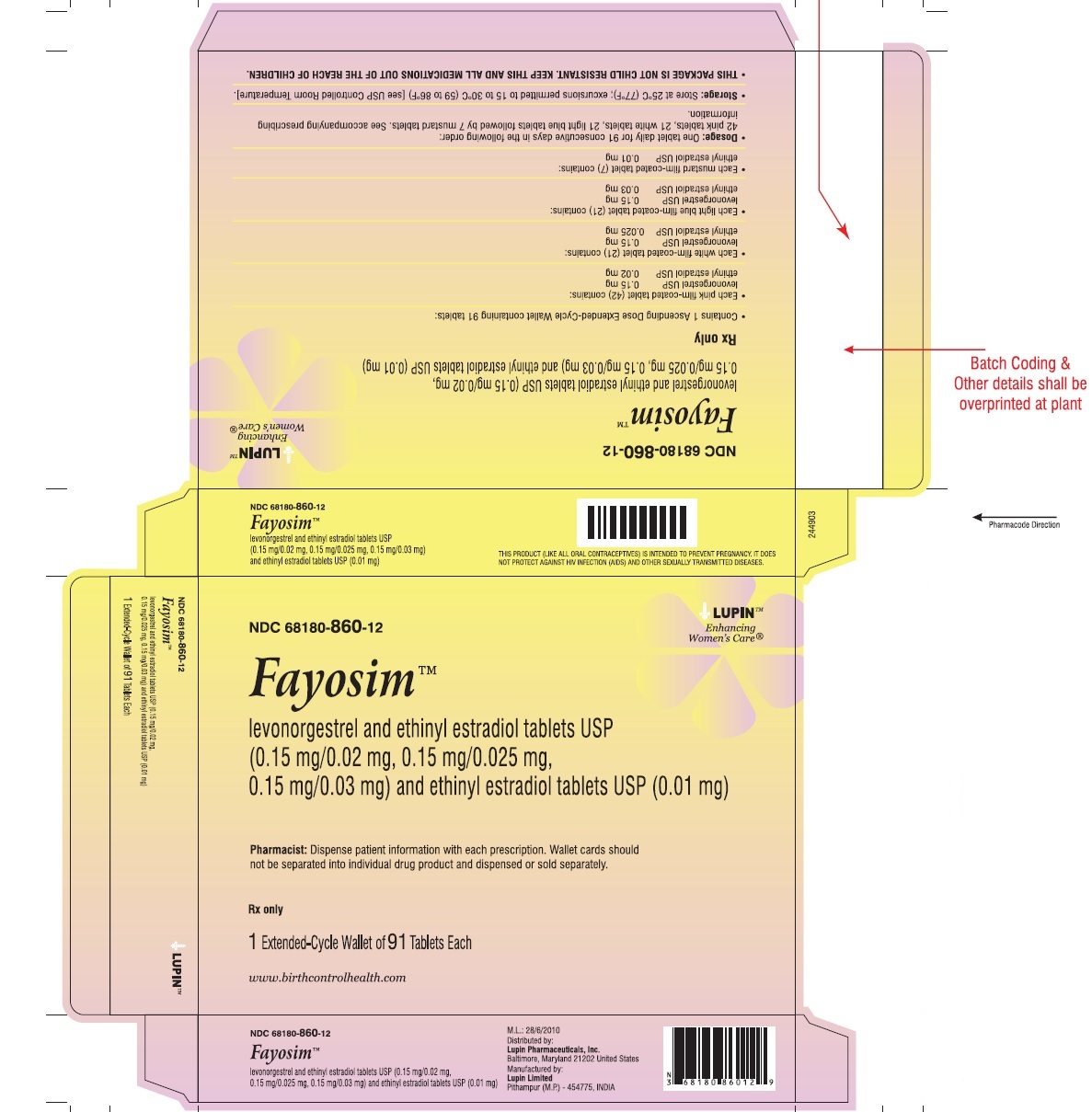
Fayosim™ (levonorgestrel and ethinyl estradiol tablets USP, 0.15 mg/0.02 mg, 0.15 mg/0.025 mg, 0.15 mg/0.03 mg and ethinyl estradiol tablets 0.01 mg)
2 extended cycle wallets of 91 tablets in a carton (NDC: 68180-860-13)
Rx Only
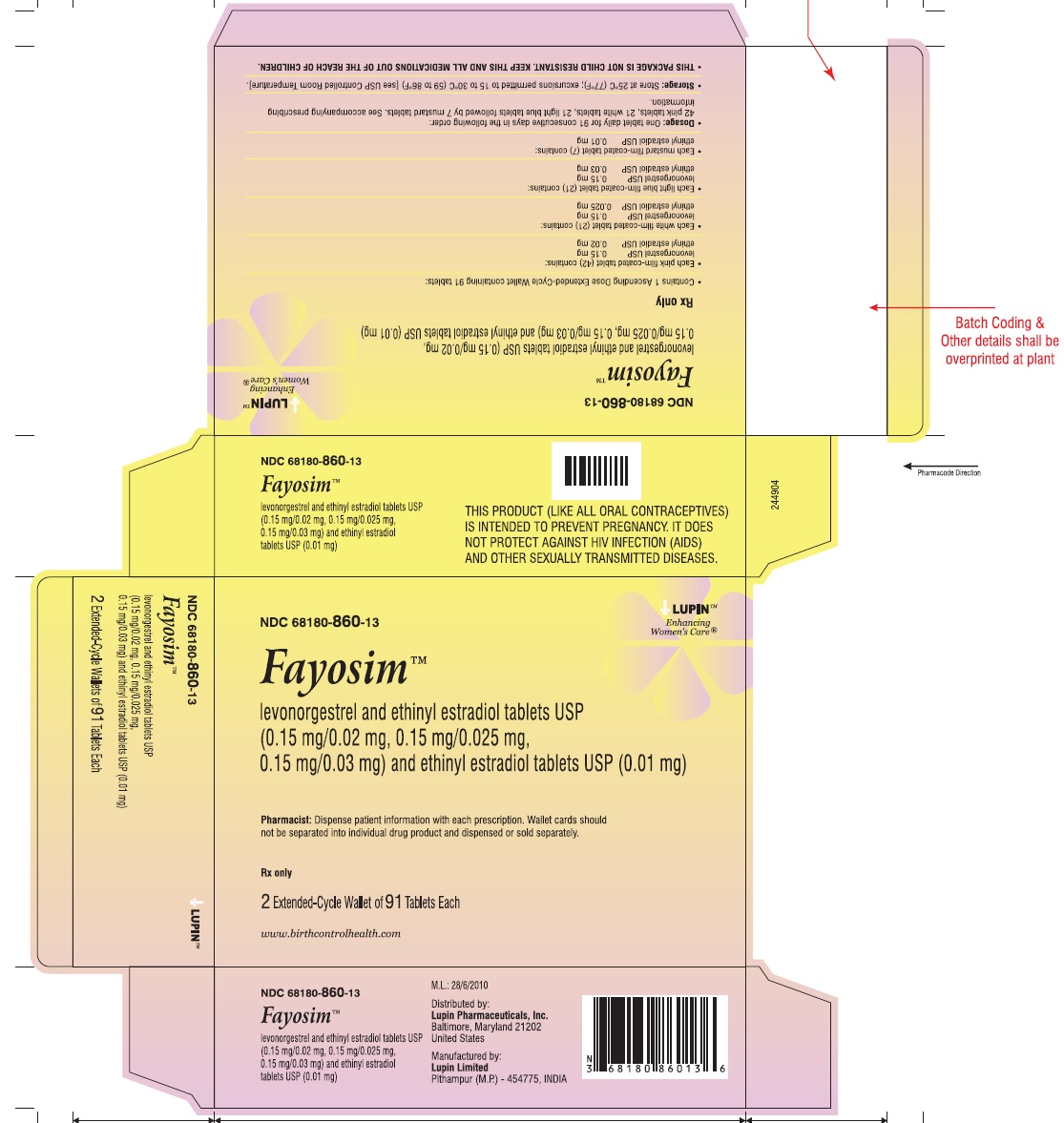
Fayosim™ (levonorgestrel and ethinyl estradiol tablets USP, 0.15 mg/0.02 mg, 0.15 mg/0.025 mg, 0.15 mg/0.03 mg and ethinyl estradiol tablets 0.01 mg)
Pouch Label (NDC: 68180-860-11)
Rx Only
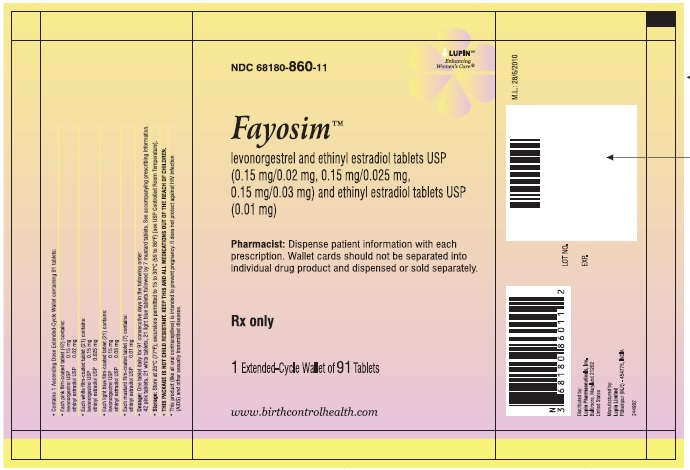
Fayosim™ (levonorgestrel and ethinyl estradiol tablets USP, 0.15 mg/0.02 mg, 0.15 mg/0.025 mg, 0.15 mg/0.03 mg and ethinyl estradiol tablets 0.01 mg)
Wallet Label (NDC: 68180-860-11)
Rx Only
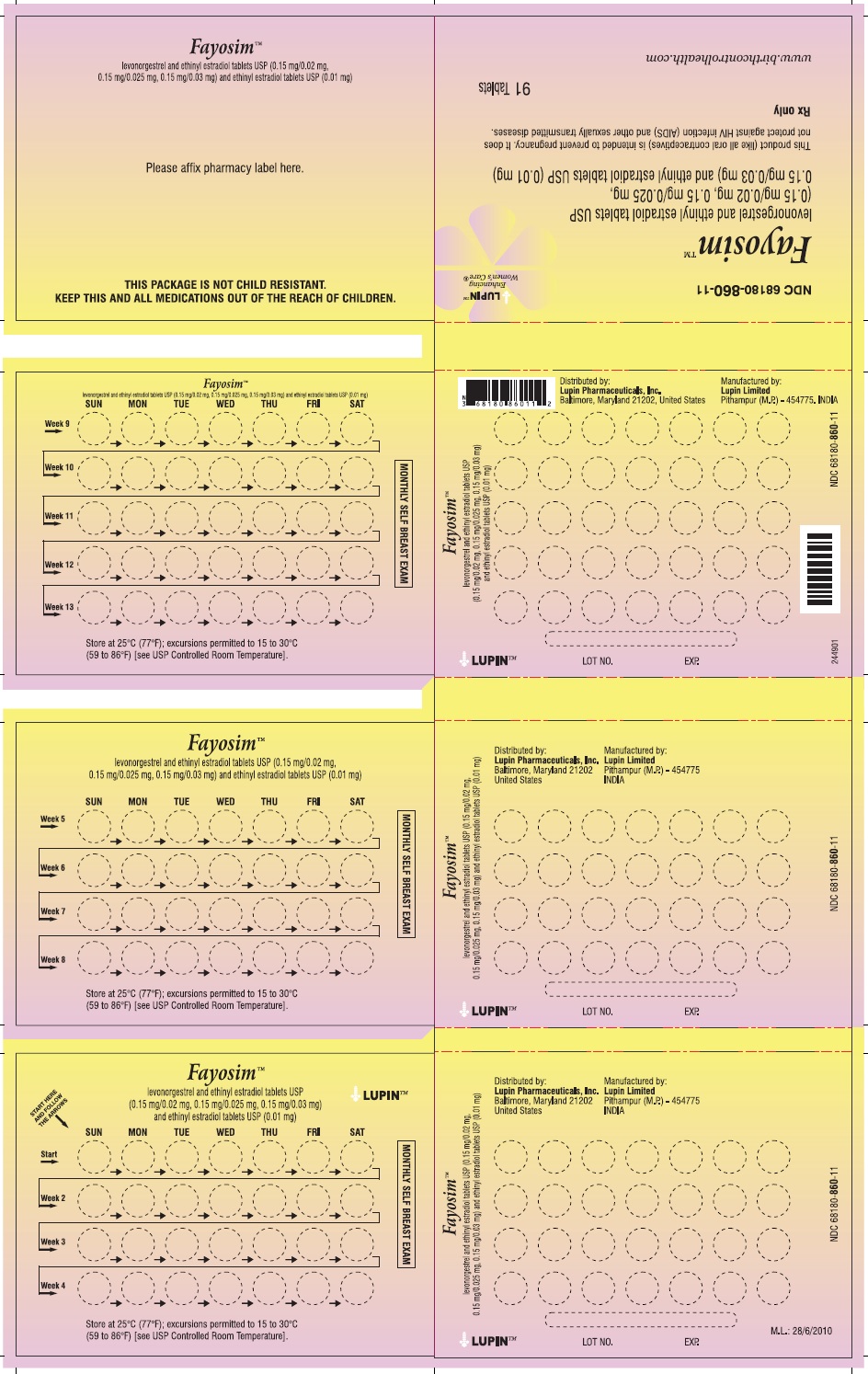
-
INGREDIENTS AND APPEARANCE
FAYOSIM
levonorgestrel and ethinyl estradiol and ethinyl estradiol kitProduct Information Product Type HUMAN PRESCRIPTION DRUG Item Code (Source) NDC: 68180-860 Packaging # Item Code Package Description Marketing Start Date Marketing End Date 1 NDC: 68180-860-12 1 in 1 CARTON 04/03/2017 1 NDC: 68180-860-11 1 in 1 POUCH 1 1 in 1 BLISTER PACK; Type 0: Not a Combination Product 2 NDC: 68180-860-13 2 in 1 CARTON 04/03/2017 2 1 in 1 POUCH 2 1 in 1 BLISTER PACK; Type 0: Not a Combination Product Quantity of Parts Part # Package Quantity Total Product Quantity Part 1 42 Part 2 21 Part 3 21 Part 4 7 Part 1 of 4 FAYOSIM
levonorgestrel and ethinyl estradiol tablet, film coatedProduct Information Route of Administration ORAL Active Ingredient/Active Moiety Ingredient Name Basis of Strength Strength LEVONORGESTREL (UNII: 5W7SIA7YZW) (LEVONORGESTREL - UNII:5W7SIA7YZW) LEVONORGESTREL 0.15 mg ETHINYL ESTRADIOL (UNII: 423D2T571U) (ETHINYL ESTRADIOL - UNII:423D2T571U) ETHINYL ESTRADIOL 0.02 mg Inactive Ingredients Ingredient Name Strength ALUMINUM OXIDE (UNII: LMI26O6933) ANHYDROUS LACTOSE (UNII: 3SY5LH9PMK) CELLULOSE, MICROCRYSTALLINE (UNII: OP1R32D61U) CROSCARMELLOSE SODIUM (UNII: M28OL1HH48) FD&C BLUE NO. 1 (UNII: H3R47K3TBD) FD&C RED NO. 40 (UNII: WZB9127XOA) HYPROMELLOSES (UNII: 3NXW29V3WO) MAGNESIUM STEARATE (UNII: 70097M6I30) POLYETHYLENE GLYCOL, UNSPECIFIED (UNII: 3WJQ0SDW1A) POVIDONE (UNII: FZ989GH94E) TITANIUM DIOXIDE (UNII: 15FIX9V2JP) Product Characteristics Color PINK Score no score Shape ROUND (biconvex) Size 6mm Flavor Imprint Code LU;U19 Contains Marketing Information Marketing Category Application Number or Monograph Citation Marketing Start Date Marketing End Date ANDA ANDA205943 04/03/2017 Part 2 of 4 FAYOSIM
levonorgestrel and ethinyl estradiol tablet, film coatedProduct Information Route of Administration ORAL Active Ingredient/Active Moiety Ingredient Name Basis of Strength Strength LEVONORGESTREL (UNII: 5W7SIA7YZW) (LEVONORGESTREL - UNII:5W7SIA7YZW) LEVONORGESTREL 0.15 mg ETHINYL ESTRADIOL (UNII: 423D2T571U) (ETHINYL ESTRADIOL - UNII:423D2T571U) ETHINYL ESTRADIOL 0.025 mg Inactive Ingredients Ingredient Name Strength ANHYDROUS LACTOSE (UNII: 3SY5LH9PMK) CELLULOSE, MICROCRYSTALLINE (UNII: OP1R32D61U) CROSCARMELLOSE SODIUM (UNII: M28OL1HH48) HYPROMELLOSES (UNII: 3NXW29V3WO) MAGNESIUM STEARATE (UNII: 70097M6I30) POLYETHYLENE GLYCOL, UNSPECIFIED (UNII: 3WJQ0SDW1A) POVIDONE (UNII: FZ989GH94E) TITANIUM DIOXIDE (UNII: 15FIX9V2JP) Product Characteristics Color WHITE Score no score Shape ROUND (biconvex) Size 6mm Flavor Imprint Code LU;U20 Contains Marketing Information Marketing Category Application Number or Monograph Citation Marketing Start Date Marketing End Date ANDA ANDA205943 04/03/2017 Part 3 of 4 FAYOSIM
levonorgestrel and ethinyl estradiol tablet, film coatedProduct Information Route of Administration ORAL Active Ingredient/Active Moiety Ingredient Name Basis of Strength Strength LEVONORGESTREL (UNII: 5W7SIA7YZW) (LEVONORGESTREL - UNII:5W7SIA7YZW) LEVONORGESTREL 0.15 mg ETHINYL ESTRADIOL (UNII: 423D2T571U) (ETHINYL ESTRADIOL - UNII:423D2T571U) ETHINYL ESTRADIOL 0.03 mg Inactive Ingredients Ingredient Name Strength ALUMINUM OXIDE (UNII: LMI26O6933) ANHYDROUS LACTOSE (UNII: 3SY5LH9PMK) CELLULOSE, MICROCRYSTALLINE (UNII: OP1R32D61U) CROSCARMELLOSE SODIUM (UNII: M28OL1HH48) FD&C BLUE NO. 1 (UNII: H3R47K3TBD) FD&C YELLOW NO. 6 (UNII: H77VEI93A8) FERRIC OXIDE YELLOW (UNII: EX438O2MRT) HYPROMELLOSES (UNII: 3NXW29V3WO) MAGNESIUM STEARATE (UNII: 70097M6I30) POLYETHYLENE GLYCOL, UNSPECIFIED (UNII: 3WJQ0SDW1A) POVIDONE (UNII: FZ989GH94E) TITANIUM DIOXIDE (UNII: 15FIX9V2JP) Product Characteristics Color BLUE (Light) Score no score Shape ROUND (biconvex) Size 6mm Flavor Imprint Code LU;V21 Contains Marketing Information Marketing Category Application Number or Monograph Citation Marketing Start Date Marketing End Date ANDA ANDA205943 04/03/2017 Part 4 of 4 FAYOSIM
ethinyl estradiol tablet, film coatedProduct Information Route of Administration ORAL Active Ingredient/Active Moiety Ingredient Name Basis of Strength Strength ETHINYL ESTRADIOL (UNII: 423D2T571U) (ETHINYL ESTRADIOL - UNII:423D2T571U) ETHINYL ESTRADIOL 0.01 mg Inactive Ingredients Ingredient Name Strength ALUMINUM OXIDE (UNII: LMI26O6933) ANHYDROUS LACTOSE (UNII: 3SY5LH9PMK) CELLULOSE, MICROCRYSTALLINE (UNII: OP1R32D61U) FD&C YELLOW NO. 6 (UNII: H77VEI93A8) FERRIC OXIDE YELLOW (UNII: EX438O2MRT) HYPROMELLOSES (UNII: 3NXW29V3WO) MAGNESIUM STEARATE (UNII: 70097M6I30) POLACRILIN POTASSIUM (UNII: 0BZ5A00FQU) POLYETHYLENE GLYCOL, UNSPECIFIED (UNII: 3WJQ0SDW1A) POLYSORBATE 80 (UNII: 6OZP39ZG8H) TITANIUM DIOXIDE (UNII: 15FIX9V2JP) Product Characteristics Color YELLOW (Mustard) Score no score Shape ROUND (biconvex) Size 6mm Flavor Imprint Code LU;V22 Contains Marketing Information Marketing Category Application Number or Monograph Citation Marketing Start Date Marketing End Date ANDA ANDA205943 04/03/2017 Marketing Information Marketing Category Application Number or Monograph Citation Marketing Start Date Marketing End Date ANDA ANDA205943 04/03/2017 Labeler - Lupin Pharmaceuticals, Inc. (089153071) Registrant - LUPIN LIMITED (675923163) Establishment Name Address ID/FEI Business Operations LUPIN LIMITED 650582310 MANUFACTURE(68180-860) , PACK(68180-860)
Trademark Results [FAYOSIM]
Mark Image Registration | Serial | Company Trademark Application Date |
|---|---|
 FAYOSIM 87101319 5287574 Live/Registered |
Lupin Limited 2016-07-12 |
 FAYOSIM 85830127 not registered Dead/Abandoned |
Lupin Limited 2013-01-23 |
© 2025 FDA.report
This site is not affiliated with or endorsed by the FDA.